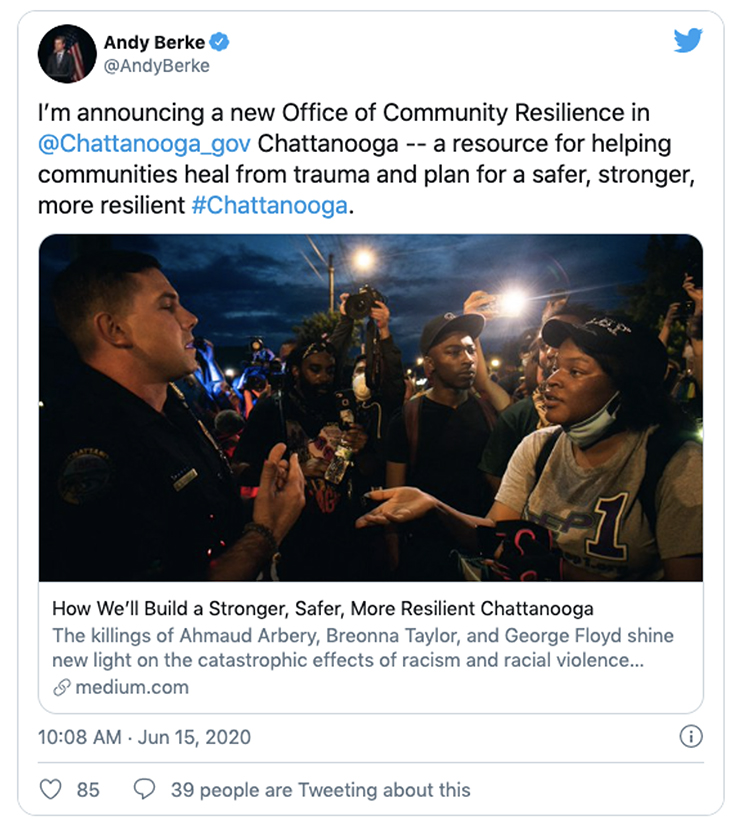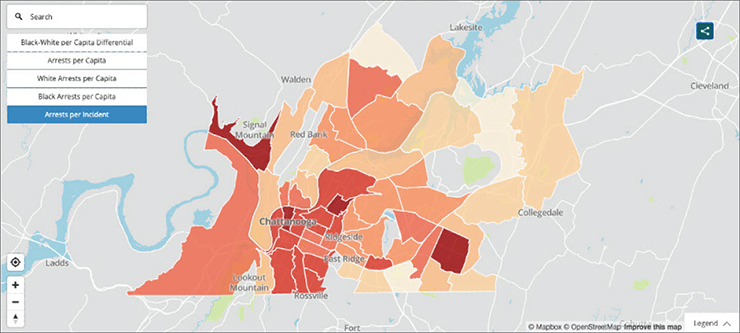Chattanooga's New Public Safety Vision
Tyler's Enterprise Data Platform Powers Data-Driven Strategy to Address Equity in Policing
Police encounters that result in arrests can have a significant impact on a person’s employment, wealth, and other socioeconomic factors. While national research shows that historically oppressed communities of color are arrested and cited at higher rates than their counterparts, the focus is beginning to shift to local analysis.
Today, local governments increasingly want to know the details of law enforcement activities in their communities to ensure public safety is equitable to all residents. The city of Chattanooga, Tennessee, is a leading example of using data to inform police equity efforts.
Connecting the Dots to Address Systemic Challenges
Chattanooga is already a leader in open data and civic engagement so taking a data-driven approach to unpack racial disparities in policing is a logical next step. This effort, led by the Office of Performance Management and Open Data and the Office of Community Resilience, both organized within the Mayor’s office, will support the reform of internal systems and community linkages to decrease the impacts of the public safety and criminal justice systems on communities of color and other vulnerable populations.
The insights and understanding drawn from this data will shape conversations and decisions about how we function as law enforcement.
David Roddy
Chattanooga Police Chief
The effort combines public safety data with census demographics, information on recidivism reduction programs, neighborhood-based planning, and even the local budget. This holistic analysis will produce insights that help open a forum to create a safer, stronger, more resilient community.

This progressive approach to police reform follows a long-standing practice in Chattanooga. The police department has implemented use of force policies, empathy-based trainings, body cameras, and de-escalation training. While these approaches improve officers’ individual tool kits, this next layer can help meaningfully address underlying societal issues and deeply entrenched challenges.
“Too often, police are asked to perform duties that fall outside their training and expertise,” wrote Chattanooga Mayor Andy Berke in an article about the effort. “They are asked to step in when social workers, mentors, housing providers, addiction specialists, or code enforcement officers are needed. Everyone agrees that this can and should change.”
Since the beginning of this endeavor, I grew more and more impressed with our data team. They not only gave insights into where we were and where we were headed, they contributed to the efforts to get us here. And that ‘here’ is very important for both us, as a law enforcement agency and us as a community.
David Roddy
Chattanooga Police Chief
The backbone of this work to change culture and improve public accountability is data.
“The Office of Community Resilience is going to be thinking about how we can break these cycles by connecting people to social programs or other programs that are more productive,” said Tim Moreland, Chattanooga director of performance management and open data.
Moreland’s team needed the cooperation of the right stakeholders and access to police and internal affairs data, in addition to developing modeling algorithms and overlaying demographic data, before they could build a holistic view of the local public safety landscape. This analysis, they theorized, would illuminate patterns and unearth policies and tactics to adjust. For example, could social services respond to specific types of non-emergency calls, rather than police?
Applying an Equitable Lens to Public Safety Data
The city of Chattanooga chose Tyler’s enterprise data platform to centralize, organize, analyze, and report public safety data. In addition to streamlining data governance, this technology creates a layer of accountability within the police department and with residents, who have access to cleaned, redacted, or aggregated data via the city’s open data portal.
Each Monday morning, Mayor Berke meets with the police chief to review this dashboard, identify areas for improvements, and applaud what’s doing well.
“To provide supported, verified information about how we function as a police department and our impact on those we serve is critical in today’s times,” said Chattanooga Police Chief David Roddy. “The insights and understanding drawn from this data will shape conversations and decisions about how we function as law enforcement.”
The dashboard supports the police department in addressing how economic-based citations impact the community, and it sheds light on potential partnerships the police department can form to help solve these issues. In addition, the data is guiding conversations with local pastors, public defenders, and residents.
“It’s about making arrests of people who commit violence, not about surging into neighborhoods that are typically majority black residents,” Berke said during the National League of Cities 2020 annual meeting. “We want to make sure that we’re using police tactics that don’t let these numbers go out of whack, and having a baseline helps us with that.”

The city’s dashboard includes several maps showing arrest data by census tract, use of force incidents, and racial demographics, which all help provide a lens toward equity.
The data team’s background with using Tyler’s data solution, which spans back to 2014, allowed them to quickly pull the data from the police records management system and stand up the dashboard with about 40 hours of work, Moreland said. With this technology, Chattanooga can easily report indicators with less time, fewer resources, and avoid manual updating of reports.
Data is shared internally for review, and then pushed out to the public on the open data portal. This approach protects the privacy of sensitive data, facilitates a robust approvals process, and gives the public access to see how the police department addresses complaints and holds its own members accountable.
“Having a data infrastructure, having good ETLs (extract, transform, load), having good partners,” Moreland said. “It made it easier to get that piece.”
The dashboard is based on several datasets, which are automatically updated nightly, that the public can visit, explore, and analyze on their own. Those datasets include arrests, citations, police incidents, internal affairs incidents, and more, with some data going back to 2012.
There was concern about protecting officers’ privacy, as well as members of the public, in the data release. The team addressed this by using unique identifiers that provide a granular level of analysis without directly tying it to an identifiable person. Furthermore, the data is described in detail — “a dissertation in data,” Moreland says — to provide valuable context.
I’m hopeful about the future because we have a progressive police department that cares, wants to be trusted by the community, and showed great leadership in getting this data out there.
Tim Moreland
Chattanooga Director of Performance Management and Open Data
Taking the First Steps to Improve Racial Equity
Insights from this data can help the city start the discussion on racial equity in policing and help identify solutions to help minority communities.
“Since the beginning of this endeavor, I grew more and more impressed with our data team,” said Chief Roddy. “They not only gave insights into where we were and where we were headed, they contributed to the efforts to get us here. And that ‘here’ is very important for both us, as a law enforcement agency and us as a community.”
Insights from the dashboard help the city in four main areas:
- Establishing a baseline to determine which calls for service need an officer
- Informing staffing for the Office of Community Resilience, and which calls that team should respond to — for example, public intoxication or overdose calls
- Helping the city establish future-looking plans when it comes to community transparency
- Changing outcomes for the public by diverting people away from the criminal justice system
“I’m hopeful about the future because we have a progressive police department that cares, wants to be trusted by the community, and showed great leadership in getting this data out there,” Moreland said. “I wish we could do more and go faster, but this is long-time work.”
Chattanooga’s model is already being replicated and used as examples to other communities that want to create a new vision of justice and public safety that includes everyone.
“Police injustice is a scar on our country,” Mayor Berke said during the National League of Cities 2020 annual meeting. “I’m optimistic that together this is the place and time where we can make progress.”